The Drawing Habit (Day 1)
Developing a daily drawing practice & the 30 Day GUT experiment begins!
Helloooo Grown-Ups Table, aka GUT peeps, aka friends! (New here? Pop into the introductions and say hi.)
Every week we explore a new area of drawing I’m curious about. Sometimes it’s an artist like Maira Kalman or Ruth Asawa. Sometimes it’s a particular element of drawing like line, space, perspective or texture. And sometimes we use drawing to wonder about the bigger picture, like, how can we bring more gratitude into our lives, or how does music effect us, or what happens when we get real quiet?
Right now I’m sitting with a big picture question that relates to drawing but also everything: as we get older and things can start to feel narrower, how do we continue to create the life we want for ourselves? In the midst of change and hard times, how do we let go of stuff we no longer want, and how do we create habits of those we do?
Something I think everyone at the Grown-Ups Table shares is an interest in bringing more creativity and connection into our lives. I’m feeling that extra strong right now. I realize that making a real deep change doesn’t come from being responsive. It comes from initiating small, steady, incremental changes. It takes a different pace, and longer commitment.
So, this week - nay, month! - I’m offering myself, you, all of us a 30-day experiment: we are going to draw EVERY DAY for the next 30 days. It’ll just take ten minutes a day, use super simple structures to create a doable drawing routine, and see how that impacts not only our drawing, but our brains, hearts and bodies.
Cool? You down??
Note: if you are like “heck no, Wendy. I prefer my drawing in 30 minutes a week chunks, TYSM.” That’s great, too. You do you! No rules in art. The weekly assignments can work that way, too. But for those of you feeling like you want to develop a more steady, regular practice and create a deeper internal shift right now, this new GUT adventure is for you. For us.
The Drawing Habit
A lot of people assume working artists make art every day. Some do. Some don’t. Some work sporadically in a frenzy and then collapse, and some keep steady bankers hours. There is no best, most effective schedule for making art. There is no “hack.” There’s only figuring out what works for you and then keep doing it. Because no matter what any artists working style may be, every artist has a practice. We have a creative routine. That routine becomes a habit1. And that art habit, well, that leads to being an artist.
How my drawing habit began.
A lot of people are surprised to learn that there was about 10 years there when I stopped drawing. Completely and totally stopped. And it was in art school of all places. I was told “drawing isn’t art, and painting is dead” (oh, 90s art school) and I was young and impressionable. So after drawing obsessively since I was little, I stopped. I went on to have interesting jobs, go to grad school, etc etc. But it wasn’t until I was about 30, commuting back and forth on the subway to a job downtown, that I started drawing again.
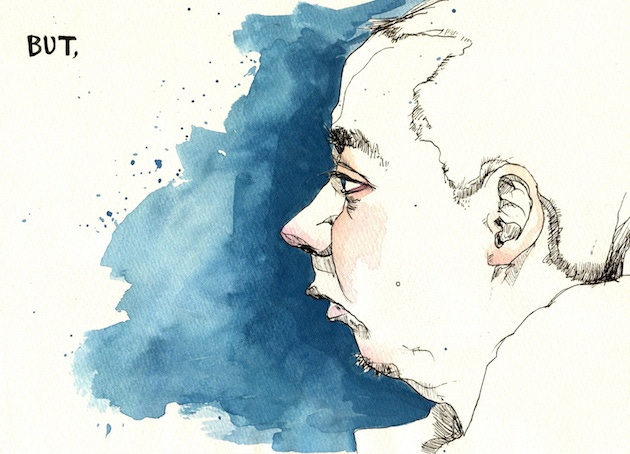
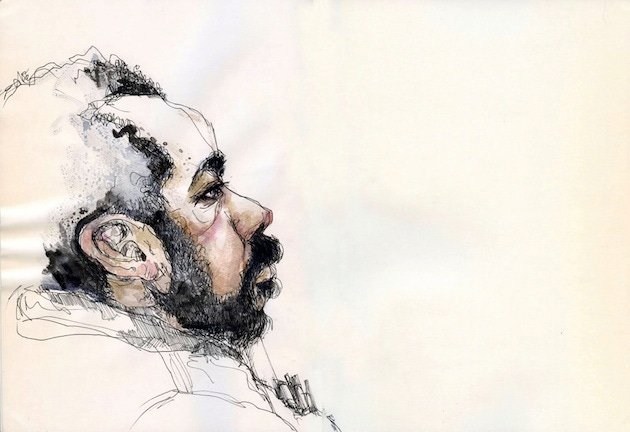
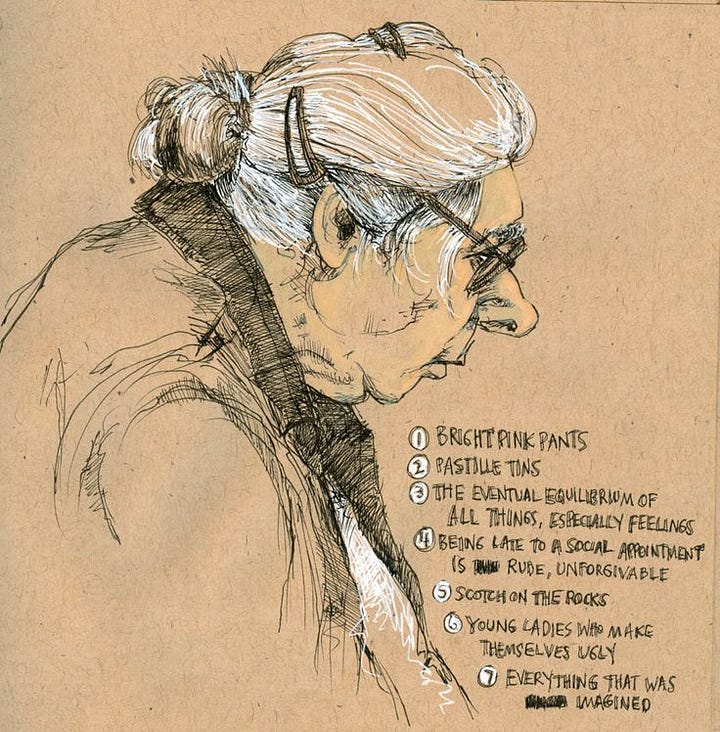
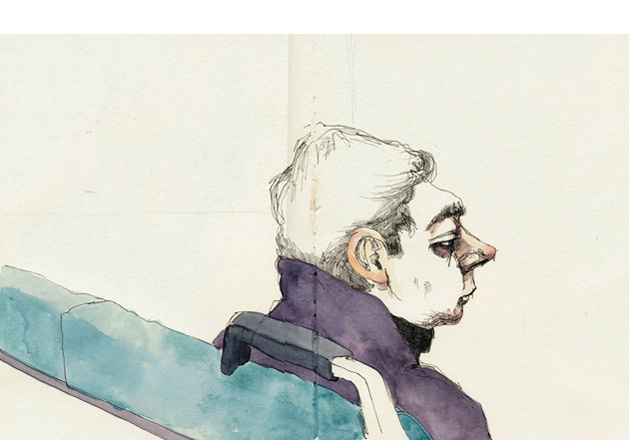
One morning in 2006, for reasons I don’t totally remember, I decided to draw a passenger in the subway car. Then I did it again on the ride home. And then I kept doing it. Every commute. Twice a day. Twenty minutes a day. I’d go home at night and paint the drawings. And I fell back in love with drawing again.
Over the next two or three years, not only did I build up a huge body of work, I developed a practice, an approach and an identity around drawing. Drawing became a compulsive habit. It taught me to look, to connect with strangers, all the skills and such - all the things I do now really started on that train. I became myself again on that train.
I do not think it would have happened if I hadn’t had that daily ritual.
These days…
I don’t draw like I used to. There’s a part of me now that feels like I’m that 20-something-year-old Wendy again, off exploring other parts of myself. But in essence, I am and will always be a drawer. I’m happiest when I’m drawing every day. When I don’t I get a little frazzled. A little anxious. A little unmoored.
Given those are super frequent feelings for me these days, I can tell it’s time for me to step back into my river. Time to get into the drawing habit.
Feel familiar?
If you, too, want to reintroduce a creative habit into your life, or maybe start one for the first time, then you’ve come to the right table. And with that, may I introduce exactly what we are going to do this week.
The 30 Day Drawing Experiment
For the next 30 days on the GUT we will do DAILY DRAWINGS. Thats ten minutes a day, every day. Every week I’ll give you new prompts and suggestions on how to encourage the regular practice. By the end of the 30 days we will have set ourselves up with a creative routine, gotten into the habit of making, developed our resilience to keep creating through challenges, learned a lot about ourselves, connected with each other - and created an entire darn body of work.
And we are going to do it together.
Creativity. Accountability. Community. The GUT trifecta.
Cool? Let’s do it.
Daily Drawings
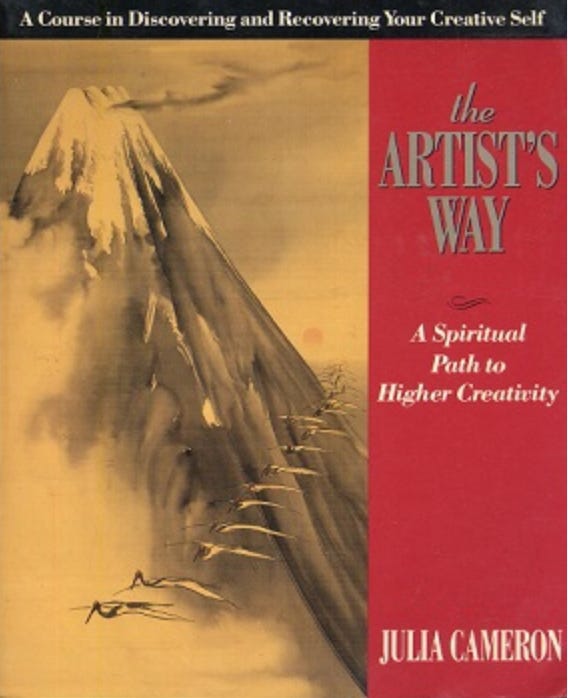
No doubt many of you have heard of The Artists Way, by Julia Cameron. The book and its practices is mostly focused on writing, but as Ms. Cameron says many visual artists have found it useful, too. One of the the exercises she suggests doing to free your creative self is “Morning Pages”: a daily free writing session done first thing in the day. Three pages. Uncensored. No backtracking. Just a verbal stream of consciousness purge onto paper. It’s about getting all the crap out of your head onto the page and allowing space for your creative self to step forward. I know successful writers who swear by this practice, and I did it myself for several months a while back. I appreciated how it loosened my brain.
And as a visual person, I’ve always wondered how this practice could be altered for someone like me. What would happen if I did “Morning Drawings”.
So this past week I tried it. And I loved it.
Every morning I sat at my kitchen table with a cup of coffee, a blank sketchbook page, a pen. I set a timer, pressed start, and drew for ten minutes.
The drawings I did were simple and repetitive. More like doodles. And unlike usual mornings when I look at my phone, after a minute or so of drawing, I noticed my mind started to settle down. A couple more minutes of drawing and my breathing noticeably changed. A couple more minutes and my shoulders dropped. As thoughts would bubble up, I’d jot them down on the same page, then just go back to drawing. Maybe I got anxious for some reason minute, but I just kept drawing and I noticed it changed again.
I was shocked when the buzzer went off. I wanted to keep drawing. But I put my pen down and walked away. The next day I woke up eager to do it again.
So this is the model we are going to use for our 30-day drawing GUT experiment. Each week we’ll have a new assignment, but those timed 10 minutes in the morning won’t change.
Let’s see how daily drawing like this changes our brains, hearts and bodies.
Thoughts on daily habits you want to share? Leave them in the comments! Love to hear what you think about this before we start.
Artist Inspiration
In Week One we’re focusing on two artists for our daily drawing inspiration. They are:
Hiroyuki Doi, whose work I learned about on an episode of writer John Green’s brilliant podcast Anthropocene Reviewed.
And Agnes Martin, who you have probably heard me talk about in DrawTogether or the GUT, and whose work John Green also speaks beautifully about in that same episode. (DrawTogether did an interactive drawing podcast episode about Agnes Martin for kids you can listen to as well.)
The three drawing structures we’re using are:
Draw in the morning, first thing if possible.
Draw in the same place every day. Doesn't matter where, but it should be someplace where you can be alone and quiet for ten minutes.
Use a timer. We’re setting our timers for ten minutes, and then now checking the clock. The idea is to focus wholly on the process of drawing, and not the outcome. By setting the timer we know we don't have to worry about drawing too much or not enough. We’ve protected the time. Once you’ve pressed start, just keep drawing and be present until the timer goes off.
Okay, I know this isn’t always possible for us. And no rules in art! So let’s just do our best to create the kind of time/space we all need. Remember, it’s just ten minutes. :)
Daily Drawing Assignments: Week 1
Exercise #1.
Let’s start with the Hiroyuki Doi inspired exercise. Definitely listen to John Green’s interview to learn more about Hiroyuki’s work and the story behind the circles. It’s a great example of the therapeutic effect of some art making.
Here is one of Hiroyuki’s circle drawings:
Set a timer for ten minutes and draw little circles with a pen or pencil. That’s it. One color. Any size or shape you want. But pay attention to the process, not the outcome. As thoughts come up, if you want to write them down, go for it. Just return to drawing circles after you’ve made the note. Or you can just let the thought go. If you notice things happening to your body (breath changing, mind racing or calming, anxiety climbing or diminishing) and you want to write that down, too, great. Notice if you feel any different at the beginning of the ten minutes than you do at the end.
This is a deceivingly simple exercise. And I found myself getting lost in it. You can watch John Green do this very thing in the video above (made during the pandemic as a video blog to his brother.)
Exercise #2
This one is inspired by Agnes Martin. It’s also very simple. For ten minutes, you are going to draw a grid. The grid above is just an example. Your grid can be any sort of perpendicular lines. It should just be simple. Nothing fancy. This is about process, not outcome.
Start on the left side of your page and make vertical lines all the way down, till you get to the right edge of the page. Then, starting at the top left, draw horizontal lines from left to right, all the way down til you get the bottom of the page.
Go slow. Try drawing one line on the inhale, and one on the exhale. If that’s not comfortable, do one breath in and out per line. See if your breathing changes. If you notice thoughts come up, you can write them off to the side. Then return to drawing. If you notice things happening with your body, mind or heart rate, maybe make note of that too, then retune to drawing. If you run out of room, just draw more lines in between the lines you drew before. Top to bottom, right to left. When the buzzer goes off, pen down. Notice if you feel any different than when you started.
That’s it.
Try both of these and see if the effect is different. Then do which ever you want to do for the rest of the week. Or do something different! What matters is that we do 10 minutes a day of slow steady drawings every day this week.
Share your daily Drawings
Our real assignment here is to draw for ten uninterrupted minutes a day, in the morning if you can. Before your head gets distracted. If you’d like to share your daily drawings in the chat, we can also use that space to share thoughts and experience on what comes up for us along the way. If you want to keep yours private, that’s great, too.
Thanks for being open to trying this experiment with me! If you all rebel, i’ll hear that! If not, then next week, we’ll do a totally different sort of daily assignment. :)
As always, everything is better….
xoxo
w
Texture Drawing Selections!
I loved hearing how much fun you all had with the texture assignment in the chat. Abi was resistant at first, but then got absorbed into the Flow. Linda compared drawing the textured ping-pong balls to throwing pottery and getting lost on the wheel. Kelly found herself noticing new textures on her neighborhood walk.
Also so many unexpected textures: Spotty Banana! Earthwords!! Bed Springs!!! Chin hairs! Farrah Fawcett!? Lol. Seems like you all inspired eachother by sharing your work - you gave each other ideas and permission to try new things and make mistakes that led to new discoveries and be silly and have fun. And you integrated previous GUT lessons on perspective and light/shadow/value. NICE WORK. I’ve included a few selections at the end. More and more people are sharing work in the chat. Chat-curious? Join us!
Truth: I might be the only person alive who hasn’t read the book “Atomic Habits”. I will skim it for this GUT adventure, but if anyone did read it and wants to give a book report to the GUT, I know we’d all love to hear your highlights. Comments, pls! <3







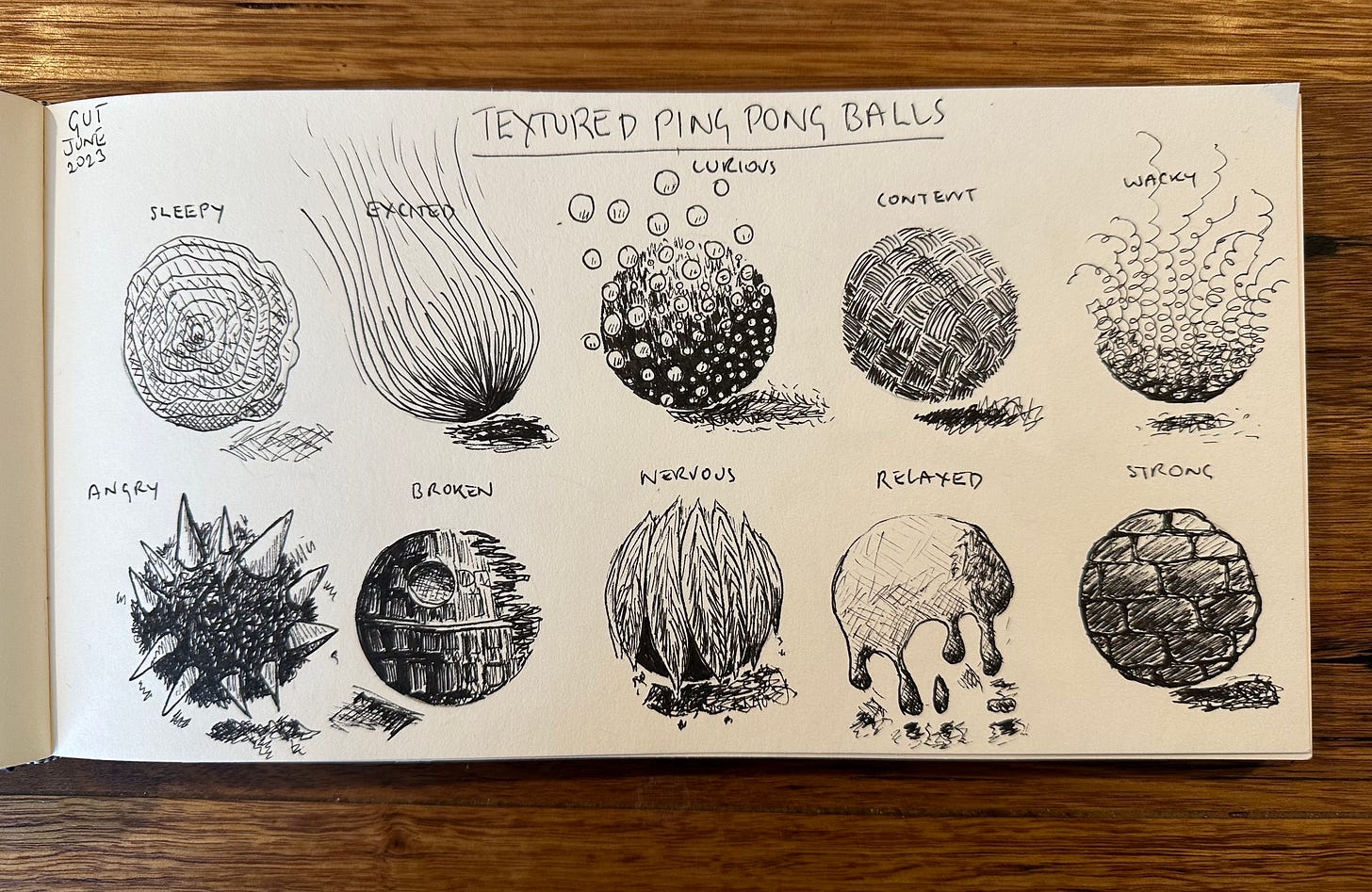

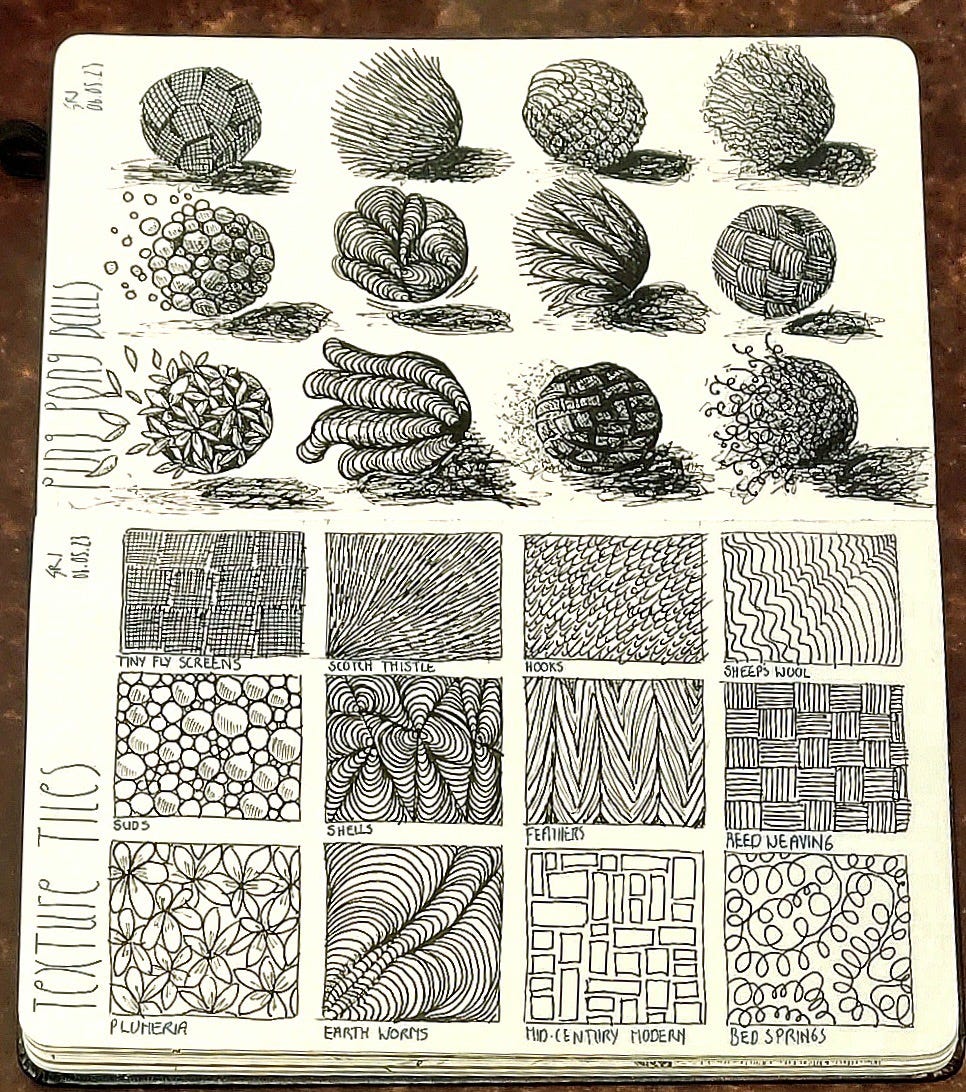
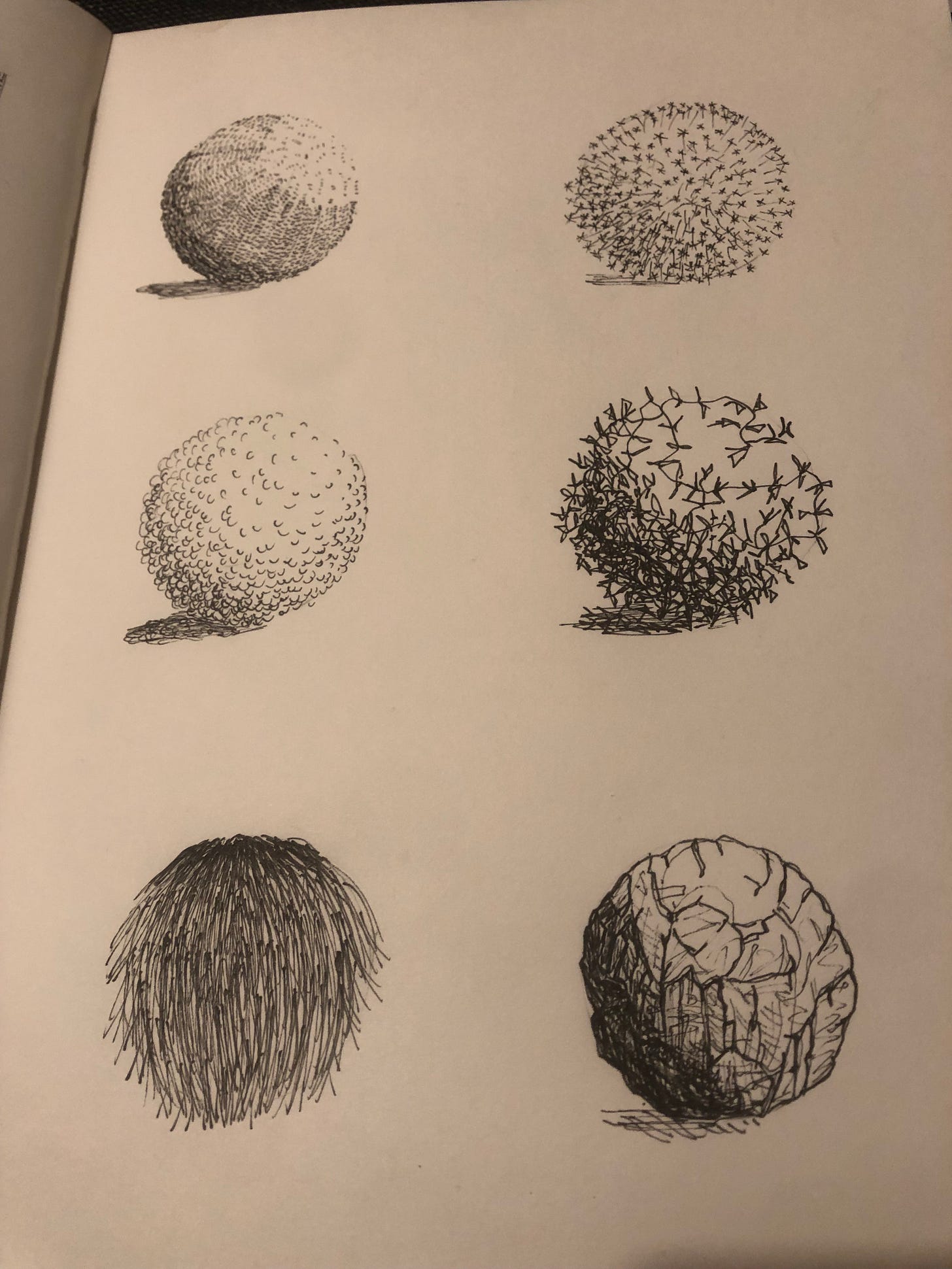
So last January 2022, I started a practice of daily drawings. My goal was 365 days of drawing and writing. I used these little 4x6 simple journals and jumped in. My only rule was I wasn’t allowed to use ANY pencil or eraser...just my black drawing pen. I was learning to let go of ‘perfection’ and to practice drawing, something I wanted to get better at. Everyday after work, I would draw a simple drawing or get inspiration from drawings I found on Pinterest. And then I would write something about it, like what I was thinking about how I did with the picture or what I was going through at the time. The journals became so much more. It was an emotional journey that continues today. I’m on year two, notebook #11, and I’ve even branched out to add watercolor to my simple drawings. But still, no pencils or erasers. I even added blind contour drawings and tried to come up with my own inspired drawings. I actually stopped recently for a few weeks because the end of school was exhausting, but have picked it back up...And I’m also one of those who has Julie Camron’s book ‘The Artist’s Way’ and have been doing morning pages at 5:00 AM since last summer :) Thank you Wendy for your continued inspiration...
“As we get older and things can start to feel narrower, how do we continue to create the life we want for ourselves? In the midst of change and hard times, how do we let go of stuff we no longer want, and how do we create habits of those we do?” THIS!!